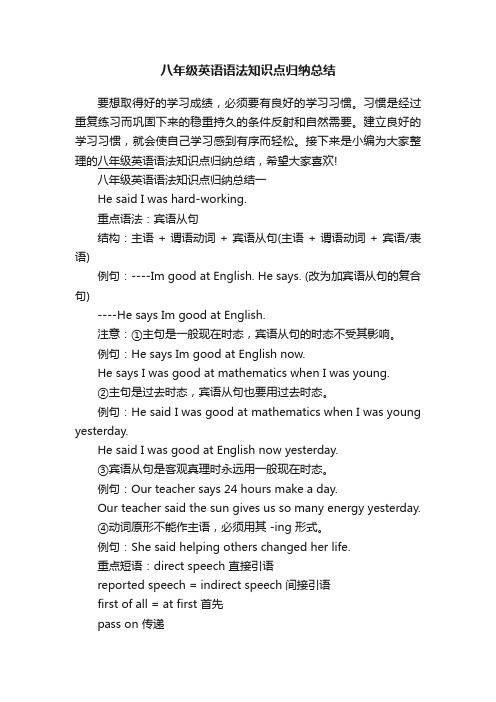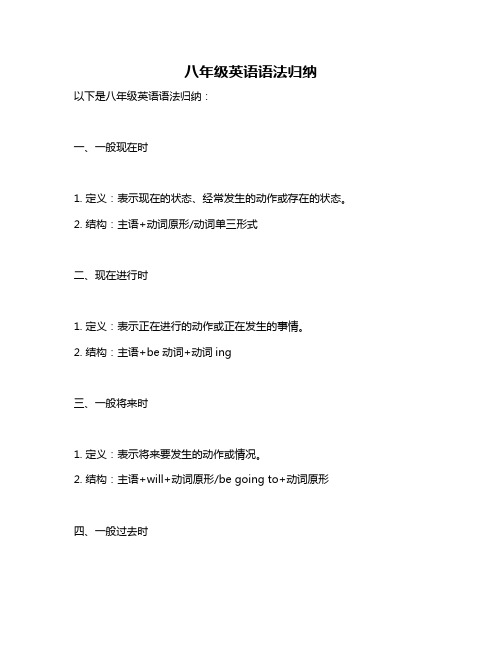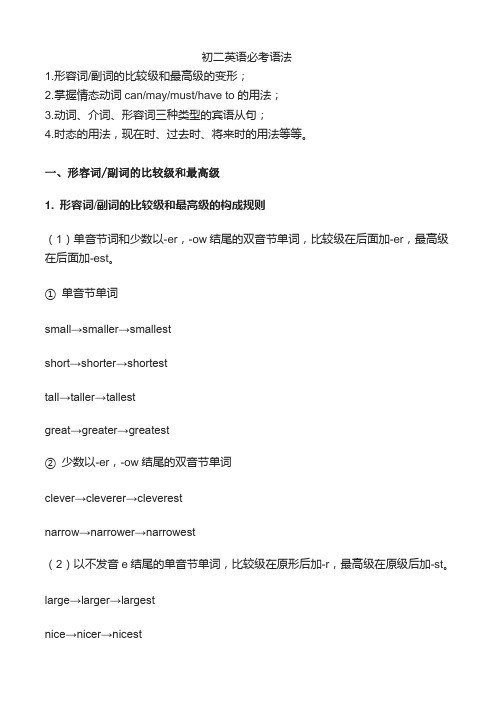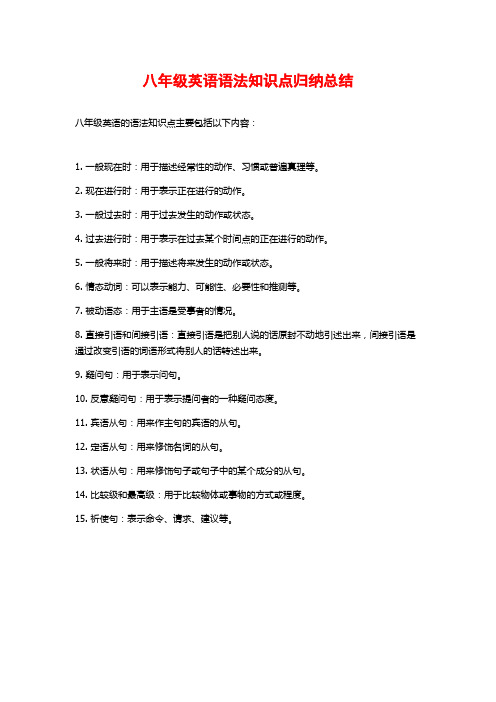初二英语语法大全
八年级英语语法点总结

八年级英语语法点总结
以下是八年级英语的一些重要语法点总结:
1. 现在完成时:表示过去发生的动作对现在的影响或结果,也可以表示过去的动作一直延续到现在。
结构为“have/has + 过去分词”。
2. 过去进行时:表示过去某一时刻正在进行的动作。
结构为“was/were + 动词的现在分词”。
3. 形容词和副词的比较级和最高级:形容词和副词有原级、比较级和最高级三种形式,用来表示不同程度的概念。
比较级用“er”或“more”表示,
最高级用“est”或“most”表示。
4. 情态动词:表示推测、可能、必要等含义的动词,如can、could、may、might、must等。
5. 被动语态:表示主语是动作的接受者,结构为“be + 过去分词”。
6. 宾语从句:用一个句子作为宾语,通常放在动词或介词后面,用来说明宾语的具体内容。
7. 定语从句:用一个句子作为定语,用来修饰名词或代词,通常放在被修饰的名词或代词之后。
8. 虚拟语气:表示与实际情况相反的情况,或者表示主观上的愿望、建议、假设等含义。
9. 不定代词:用来代替名词或形容词的代词,如something、anything、nothing等。
10. 介词和连词:用来连接两个单词、短语或句子,表示时间、地点、方式等关系的词语。
以上是八年级英语的一些重要语法点,需要学生在学习过程中逐步掌握并熟练运用。
八年级英语语法知识点归纳总结

八年级英语语法知识点归纳总结要想取得好的学习成绩,必须要有良好的学习习惯。
习惯是经过重复练习而巩固下来的稳重持久的条件反射和自然需要。
建立良好的学习习惯,就会使自己学习感到有序而轻松。
接下来是小编为大家整理的八年级英语语法知识点归纳总结,希望大家喜欢!八年级英语语法知识点归纳总结一He said I was hard-working.重点语法:宾语从句结构:主语 + 谓语动词 + 宾语从句(主语 + 谓语动词 + 宾语/表语)例句:----Im good at English. He says. (改为加宾语从句的复合句)----He says Im good at English.注意:①主句是一般现在时态,宾语从句的时态不受其影响。
例句:He says Im good at English now.He says I was good at mathematics when I was young.②主句是过去时态,宾语从句也要用过去时态。
例句:He said I was good at mathematics when I was young yesterday.He said I was good at English now yesterday.③宾语从句是客观真理时永远用一般现在时态。
例句:Our teacher says 24 hours make a day.Our teacher said the sun gives us so many energy yesterday.④动词原形不能作主语,必须用其 -ing 形式。
例句:She said helping others changed her life.重点短语:direct speech 直接引语reported speech = indirect speech 间接引语first of all = at first 首先pass on 传递be supposed to do sth. 应该做某事be good at = do well in 在某方面做得好in good health 身体健康get over 克服open up 打开care for = take care of = look after 照料;照顾not any more = not any longer = no longer 不再have a cold 感冒end-of-year exam 年终考试get nervous 变得紧张forget to do sth. 忘记做某事(该事未做)forget doing sth. 忘记做某事(该事已做)its + adj. + [for sb.] + to do sth. 做某事[对某人来说](加形容词) context 上下文Reading Strategy(阅读方法)First read for meaning, not for detail. (首先理解文段的大致意思,不在于文段的细节部分。
初二英语语法总结大全

初二英语语法总结大全一、人称代词(1)第一人称单数I代表说话者,必须大写,"我".如:I go to school every day.我每天去上学.(2)第一人称复数we代表说话者一方(二人或者二人以上)"我们".如:We are swimming now.我们现在正在游泳.(3)第二人称单数、复数you代表听话者或者对方(复数you代表二人或二人以上).如:Are you ready, Sam? 萨姆,你准备好了吗?(4)第三人称包括he、she、it. He "他" 代表已经提到过的男人. She"她" 代表已经提到过的女人.It "它"代表已经提到过的事物.如:He is the tallest in the class. 他在班里是最高的.She has a little brother. 她有个小弟弟.、I have a handbag. It is black. 我有个手提包,它是黑色的.(5)第三人称复数they "他们" 代表已经提到过的一些人或者一些事物,这个词没有性别之分.如:Where are the teachers? They are over there. 老师们在哪里?他们在那边.Where are the apples? They are in the drawer. 苹果在哪里?它们在抽屉里.注:1)人称代词主格在句中主要做主语.如:We went to the zoo yesterday.我昨天去动物园了.2) 人称代词宾格在句中主要作宾语.如:Can you help me? 你能帮我吗?3)人称代词做表语时一般用宾格.如:Who is that? It's me. 是谁呀?是我.4)在比较状语从句中,在不引起误解的前提下,有时用宾格代词代替主格代词.如:He is taller than me. 它比我高.He loves you more than me. 她爱你胜过爱我.5)两个以上的代名词并行排列时,其次序为:a) 单数人称代词:you he I.如:You, he and I are good friends. 你我他都是好朋友.b) 复数人称代词为:we you they.如:We and they went to the Great Wall yesterday. 我们和他们昨天都去长城了.c) 第三人称He和she 同时使用时,先说he,后说she.如:He and she were late for school this morning.他和她今天早上都上学迟到了.二、宾语从句1、从属连接词1)that引导宾语从句时,that在从句中补充当任何成分,在口语或非正式语中常被省略。
八年级英语语法归纳

八年级英语语法归纳以下是八年级英语语法归纳:一、一般现在时1. 定义:表示现在的状态、经常发生的动作或存在的状态。
2. 结构:主语+动词原形/动词单三形式二、现在进行时1. 定义:表示正在进行的动作或正在发生的事情。
2. 结构:主语+be动词+动词ing三、一般将来时1. 定义:表示将来要发生的动作或情况。
2. 结构:主语+will+动词原形/be going to+动词原形四、一般过去时1. 定义:表示过去的动作或状态。
2. 结构:主语+动词过去式五、形容词和副词的比较级和最高级1. 比较级:形容词和副词的比较级形式,表示“更……”。
2. 最高级:形容词和副词的最高级形式,表示“最……”。
六、情态动词1. can/could:表示能力、请求许可等。
2. may/might:表示可能性、请求许可等。
3. must:表示必要性、推测等。
4. should/ought to:表示建议、责任等。
5. will/would:表示意愿、将来时等。
6. need:表示需要。
7. dare:表示勇气、敢做某事等。
8. shall/should:表示计划、命令等。
9. will/would:表示意愿、请求等。
10. used to:表示过去经常发生的动作或状态。
11. had better:表示建议或劝告。
12. would rather:表示更愿意做某事。
13. had better not:表示最好不要做某事。
14. would rather not:表示不太愿意做某事。
15. needn't:表示不需要做某事。
16. daren't:表示不敢做某事。
17. shouldn't/ought not to:表示不应该做某事。
18. needn't have done:表示本来不必做某事,但实际上已经做了。
19. dare not do:表示不敢做某事。
初二英语语法大全

初二英语必考语法1.形容词/副词的比较级和最高级的变形;2.掌握情态动词can/may/must/have to的用法;3.动词、介词、形容词三种类型的宾语从句;4.时态的用法,现在时、过去时、将来时的用法等等。
一、形容词/副词的比较级和最高级1. 形容词/副词的比较级和最高级的构成规则(1)单音节词和少数以-er,-ow结尾的双音节单词,比较级在后面加-er,最高级在后面加-est。
①单音节单词small→smaller→smallestshort→shorter→shortesttall→taller→tallestgreat→greater→greatest②少数以-er,-ow结尾的双音节单词clever→cleverer→cleverestnarrow→narrower→narrowest(2)以不发音e结尾的单音节单词,比较级在原形后加-r,最高级在原级后加-st。
large→larger→largestnice→nicer→nicestable→abler→ablest(3)以一个辅音字母结尾的闭音节(即:辅音+元音+辅音)单词中,先双写末尾的辅音字母,比较级加-er,最高级加-est。
big→bigger→biggesthot→hotter→hottestfat→fatter→fattest(4)以“辅音字母+y”结尾的双音节词,把y改为i,比较级加-er,最高级加-est。
easy→easier→easiestheavy→heavier→heaviestbusy→busier→busiesthappy→happier→happiest(5)其他双音节词和多音节词,比较级在前面加more,最高级在前面加most。
beautiful→more beautiful→most beautifuldifferent→more different→most differenteasily→more easily→most easily(6)有少数形容词、副词的比较级和最高级是不规则的,必须熟记。
八年级英语语法知识点归纳总结

八年级英语语法知识点归纳总结
八年级英语的语法知识点主要包括以下内容:
1. 一般现在时:用于描述经常性的动作、习惯或普遍真理等。
2. 现在进行时:用于表示正在进行的动作。
3. 一般过去时:用于过去发生的动作或状态。
4. 过去进行时:用于表示在过去某个时间点的正在进行的动作。
5. 一般将来时:用于描述将来发生的动作或状态。
6. 情态动词:可以表示能力、可能性、必要性和推测等。
7. 被动语态:用于主语是受事者的情况。
8. 直接引语和间接引语:直接引语是把别人说的话原封不动地引述出来,间接引语是通过改变引语的词语形式将别人的话转述出来。
9. 疑问句:用于表示问句。
10. 反意疑问句:用于表示提问者的一种疑问态度。
11. 宾语从句:用来作主句的宾语的从句。
12. 定语从句:用来修饰名词的从句。
13. 状语从句:用来修饰句子或句子中的某个成分的从句。
14. 比较级和最高级:用于比较物体或事物的方式或程度。
15. 祈使句:表示命令、请求、建议等。
人教版八年级英语语法知识点归纳总结
人教版八年级英语语法知识点归纳总结八年级英语语法知识点归纳总结如下:
1. 一般现在时:表示经常性或习惯性的动作、真理、客观事实等。
2. 现在进行时:表示当前正在进行的动作。
3. 一般过去时:表示过去某个时间或状态的动作。
4. 过去进行时:表示过去某个时间正在进行的动作。
5. 一般将来时:表示将来要发生的动作或存在的状态。
6. 现在完成时:表示过去某个时间开始,一直延续到现在或刚刚结束的动作。
7. 过去完成时:表示过去某个时间之前已经发生的动作。
8. 被动语态:表示主语是动作的承受者。
9. 情态动词:表示可能性、能力、愿望、推测等情态。
10. 定语从句:用来修饰名词或代词的从句。
11. 名词性从句:在句子中充当名词的从句。
12. 状语从句:在句子中充当状语的从句。
13. 直接引语和间接引语的转换:将别人的话改写成自己的话,或将自己的话变成引用别人的话。
14. 倒装句:为了强调某个部分或使句子更加流畅而改变主谓语的位置。
15. 非谓语动词:包括不定式、动名词和现在分词等形式。
这些是八年级英语常见的语法知识点,希望对你有帮助。
如
有其他问题,请随时提问。
初二 英语语法基础知识大全
初二英语语法基础知识大全一、英语语法基础知识概述英语语法是英语学习的基础,它包括词性、句子结构、时态、语态等方面。
掌握英语语法知识有助于更好地理解和表达英语。
二、名词词性与用法1.名词分类:可数名词、不可数名词、专有名词和普通名词。
2.名词所有格:表示名词的所属关系。
3.名词复数形式:规则变化和不规则变化。
三、动词时态与语态1.动词时态:一般现在时、一般过去时、一般将来时、现在进行时等。
2.动词语态:主动语态、被动语态。
四、代词与介词1.代词:人称代词、物主代词、指示代词、疑问代词等。
2.介词用法:介词+名词、介词+动词等。
五、形容词与副词1.形容词:原级、比较级、最高级。
2.副词:程度副词、时间副词、地点副词等。
六、并列句与复合句1.并列句:用并列连词连接两个或多个简单句。
2.复合句:一个主句和一个或多个从句构成。
七、情态动词与虚拟语气1.情态动词:可能性、必要性、推测等。
2.虚拟语气:与现实相反的句子表达。
八、疑问句与否定句1.疑问句:一般疑问句、特殊疑问句、选择疑问句等。
2.否定句:在句子中加入否定词或用部分倒装。
九、直接引语与间接引语1.直接引语:直接跟在动词后面的宾语。
2.间接引语:通过连词或介词引导的宾语。
十、汉语与英语语法差异1.语序差异:汉语主谓宾,英语主谓宾。
2.词性差异:汉语词性较少,英语词性丰富。
3.动词变化差异:汉语动词无变化,英语动词有时态、语态变化。
通过掌握以上英语语法基础知识,同学们可以更好地应对英语学习中的各种问题。
初二英语语法重点归纳
初二英语语法重点归纳在初二的英语学习中,语法知识变得更加丰富和复杂。
掌握好这些重点语法,对于提高英语水平和应对各种考试都至关重要。
接下来,让我们一起对初二英语的重要语法点进行归纳。
一、一般过去时一般过去时表示过去某个时间发生的动作或存在的状态,常与表示过去的时间状语连用,如 yesterday(昨天)、last week(上周)、last month(上个月)、last year(去年)等。
其构成形式为:主语+动词的过去式+其他。
动词的过去式分为规则变化和不规则变化。
规则变化通常是在动词原形后加 ed,如 play played,work worked 。
不规则变化则需要特别记忆,如 go went,come came 等。
在使用一般过去时的时候,要注意句子中时间状语的使用,以及动词过去式的正确形式。
二、现在完成时现在完成时表示过去发生的动作对现在造成的影响或结果,或者从过去开始一直持续到现在的动作或状态。
构成形式为:主语+ have/has +过去分词。
现在完成时常与already(已经)、yet(还,尚未)、ever(曾经)、never(从不)、for +时间段、since +时间点等连用。
例如:I have already finished my homework(我已经完成了我的作业。
) He has lived here since 2010(他自 2010 年以来就住在这里。
)要注意区分一般过去时和现在完成时的用法,一般过去时强调过去的动作,与现在没有关系;而现在完成时强调过去的动作对现在的影响或与现在的联系。
三、过去进行时过去进行时表示过去某个时刻或时间段正在进行的动作。
其构成形式为:主语+ was/were +现在分词。
常与 at that time (在那时)、at this time yesterday(昨天这个时候)等时间状语连用。
例如:I was reading a book at eight o'clock last night(昨晚八点我正在读书。
初二英语语法知识点总结
初二英语语法知识点总结在初二英语的学习中,语法知识的掌握对于提升英语水平至关重要。
下面为大家总结一下初二英语中常见的语法知识点。
一、时态1、一般过去时一般过去时表示过去某个时间发生的动作或存在的状态。
常与表示过去的时间状语连用,如:yesterday(昨天),last week(上周),last month(上个月),last year(去年),two days ago(两天前),in 1990(在 1990 年)等。
其构成形式为:主语+动词的过去式+其他。
例如:I played basketball yesterday (我昨天打篮球了。
)动词过去式的变化规则:(1)一般在动词末尾加 ed,如:play played ,clean cleaned 。
(2)以不发音的 e 结尾的动词,在词尾加 d,如:live lived ,hope hoped 。
(3)以重读闭音节结尾且末尾只有一个辅音字母的动词,双写这个辅音字母再加 ed,如:stop stopped ,plan planned 。
(4)以“辅音字母+y”结尾的动词,变 y 为 i 再加 ed,如:study studied ,cry cried 。
2、现在完成时现在完成时表示过去发生或已经完成的动作对现在造成的影响或结果,或从过去已经开始,持续到现在的动作或状态。
常与 already(已经),yet(还,尚未),ever(曾经),never(从不),for +时间段,since +时间点等连用。
其构成形式为:主语+ have/has +动词的过去分词+其他。
例如:I have already finished my homework (我已经完成作业了。
)动词过去分词的变化规则与过去式的变化规则基本相同。
3、过去进行时过去进行时表示过去在某一时刻或某一段时间正在进行的动作。
常与 at this time yesterday(昨天这个时候),at that time(在那时),from eight to ten yesterday morning(昨天早上八点到十点)等连用。
- 1、下载文档前请自行甄别文档内容的完整性,平台不提供额外的编辑、内容补充、找答案等附加服务。
- 2、"仅部分预览"的文档,不可在线预览部分如存在完整性等问题,可反馈申请退款(可完整预览的文档不适用该条件!)。
- 3、如文档侵犯您的权益,请联系客服反馈,我们会尽快为您处理(人工客服工作时间:9:00-18:30)。
中考重点句型
一、常使用动词不定式的短语
1、It’s time to do sth.\ It’s time for sth
该作某事的时候了.
2、can’t wait to do sth. 迫不及待要作某事
3、ask /telle sb. (not ) to do sth.
要求/告诉某人(不)作某事
4、allow sb. to do sth. 允许某人作某事
5、be supposed to do sth. 应该作某事
6、Would like /want (sb.) to do sth. 想要作某事
7、have sth/nothing to do 有…时要做/与…无关
8、find it +adj. to do sth. 发觉作某事…
9、prefer to do sth. rather than do sth.
宁愿作某事,而不愿作某事
10、It’s +adj. for sb. to do sth.
作某事对某人来说…
11、It’s better /best to do sth. 最好做某事
12、It takes sb. sometime. to do sth.
某人做某事用了一些时间
二、常用动名词的短语
1、 enjoy /like /love doing sth. 喜欢做某事
2、 keep /keep on /carry on / go on doing sth. 继续做某事
3、feel like doing sth. 想要做某事
4、practise doing sth. 练习作某事
5、give up doing sth. 放弃作某事
6、be good at= do well in\on doing sth. 擅长作某事
7、pay attention to doing sth. 注意作某事
8、what about/ how about doing sth.
….怎么样(好吗)?
9、Thank you for doing sth. 为…感谢某人
10、mind doing sth. 介意作某事
11、be used for doing sth./ be used to do sth. 、
被用来作某事
12、spend …(in) doing sth. 花时间作某时
13、be busy doing/ with sth. 忙于作某事
14、finish doing sth. 作完某时
15、look forward to doing. 盼望做某事
16、prefer doing sth. to doing sth. 喜欢…胜过…
17、be/get used to doing sth. 习惯作某事
18、keep / stop/ prevent sb. from doing sth.
阻止某人作某事
三、省略动词不定式的短语
1、一看二听三使役
see/ hear/ feel/ notice/ look at /listen to sb. do sth. 看见/听见/感觉/注意某人作某事
make /let /have sb. do sth. 使/让某人做某事
2、help sb. (to) do sth/ with sth.帮助某人作某事
3、 had better (not) do sth. 最好(不)做某事
4、 Why don’t you/ not do sth.为什么不作某事
5、Would /Will / Could you please (not) do sth.
请你(不)作某事好吗?
四、同义词比较
1、 stop to do sth. 停下正在做的事去作另一件事
stop doing sth. 停止正在作的事
eg. When the teacher came into the classroom, the students stopped talking. After he worked for an hour, he stopped to have a rest.
2、 forget / remember to do sth.
忘记/记得要去作某事
forget / remember doing sth.
忘记记得曾经做过某事
eg. Please remember to bring my book to school.
I remember doing my homework
3、 used to do sth. 过去常常作某事
be used to do sth. 被用来作某事
be used to doing sth. 习惯于作某事
eg. My father used to smoke.
Wood is used to make paper.
I am used to getting up early.
4、So +be/助动词/情态动词 + 主语
…也一样
So +主语+be/助动词/ 情态动词
是呀,表示赞同别人的观点
Neither + be /助动词/ 情态动词+主语
…也不一样(用于否定句)
eg. He has been to Beijing. So have I.
It’s a fine day. So it is.
She doesn’t like eggs. Neither do I.
5、 too…to do sth. 太…而不能…
so +adj. /adv + that(从句) 如此…以致…
such +(a/an +adj.)+n.+ that(从句)
如此…以致…
(not) enough (for sb.) to do sth.
(对某人来说)做某事(不)够
eg. The boy is too young to go to school.
The boy is so young that he can’t go to school. He is such a young boy that he can’t go to school. The boy is not old enough to go to school.
五、常考知识点
1、keep +adj. 保持…状态
keep (sb.) doing sth.
继续做某事/使某人老是做某事
eg. Everyone should keep our classroom clean.
It’s too late, but he still keeps working.
Lily always keeps us waiting for her.
2、make+ sb. + n. 使某人成为
make + sb. + adj. 使某人…
make sb. do sth. 使某人做某事
Sb. be made to sth. 某人被迫做某事
eg. We made Peter our monitor.
Books make us happy.
He often makes me laugh.
The workers were made to work 12 hours a day.
3、I don’t think that 我认为…不
eg. I don’t think you are right.
4、It’s /was/has been+ some time +since+一般过去时…
自从…以来有多久了
eg. It has been two years since we met last time.
6、 What do you mean by?=What does .. mean?=what is the meaning of...?
是什么意思?
eg. What do you mean by “computer”?=What does “computer”mean?=what is the meaning of "computer"?
7、 What do you think of…/How do you like …?
你认为…怎么样?
eg. What do you think of this film /How do you like this film?
8、 What is/was/will …be like? ..怎么样?
eg. What is the weather like?
What will the life in the future be like?
9、 It’s said/ reported that…据说/据报道
It's well known that 众所周知
It's thought that 大家认为。
